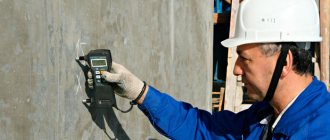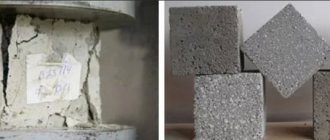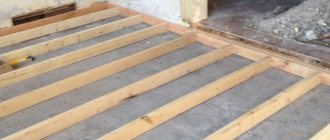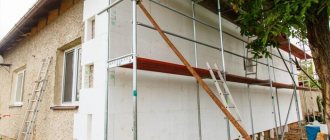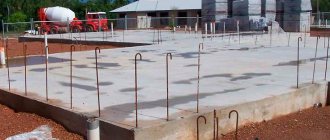Characteristic
Perhaps the most important property of a concrete mixture is its ability to spread under the influence of its mass or additional load.
The concrete mixture has one very important property - the ability to spread, thanks to which it is possible to produce products of various shapes.
It is thanks to this property that a huge number of products of a wide variety of shapes can be obtained from it, and in addition, it is possible to use it for various compaction methods. The properties of a mixture, such as its fluidity and the way it was compacted, are closely related. For example, those with low fluidity require vigorous compaction, and the formation of concrete products from them must be accompanied by active compaction in the form of intense vibration or vibration with an additional load. Other well-known compaction methods are pressing, compaction, and rolling.
Mixtures with high mobility are quickest and easiest to compact using vibration. Compressive types of compaction such as rolling, pressing or compaction, on the other hand, are not suitable for them. Under the pressure of the impact of the tamper or strong pressing movements, concrete with high fluidity is splashed by the tamper or easily flows out from under the press.
Cast ones have the ability to increase density under the influence of their own mass. In order to further compact the concrete, short-term vibration is sometimes used.
Determining the hardness of a concrete mixture using a special device
To summarize the above, the following compaction methods can be distinguished: vibration, rolling, pressing, casting, ramming and bayoneting. Vibration is the most effective method both economically and technically. It is successfully used in combination with other types of mechanical compaction - pressing (vibro-compression), compaction (vibro-ramming), rolling (vibro-rolling). One type of mechanical compaction of a concrete mixture with high fluidity is centrifugation, which is used to form hollow products with a round cross-section. In obtaining high-quality mixtures, the operation of vacuuming concrete during its mechanical compaction by vibration has proven itself well, although due to the long duration of this process, its economic effect is noticeably reduced.
Physico-mechanical principles of compaction of concrete mixtures
High-quality concrete can be obtained by using high-quality materials, correctly selecting the composition of the concrete mixture, effectively compacting it and creating optimal conditions for concrete hardening.
The concrete mixture placed in monolithic structures is compacted by bayoneting, tamping, vibrating and vacuuming. The purpose of compaction is to ensure that the concrete mixture is well filled into the formwork form and to achieve the best packaging of the particles included in it. Well-compacted concrete has a higher density; its volumetric mass, compared to an uncompacted concrete mixture, increases from 2.2 to 2.4-2.5 t/m3. The strength, frost resistance, and water resistance of concrete increase, and its other properties improve.
The mixture is bayoneted manually using screws. Due to the labor intensity and low productivity of this method, it is used in exceptional cases for compacting concrete mixtures in thin-walled and densely reinforced structures. Laying highly flexible mixtures (with a cone draft of more than 10 cm) and cast ones is also carried out using lacing to avoid their delamination during vibration.
The concrete mixture is compacted using manual and pneumatic tampers. This method is rarely used - when laying very rigid concrete mixtures in lightly reinforced structures, as well as in cases where it is impossible to use vibrators due to the negative impact of vibration on nearby equipment.
The main method of compacting concrete mixtures is vibration, or vibration compaction. This method is used to compact mixtures with a cone draft of 0 to 10 cm.
The essence of the vibration compaction process can be simplified as follows. The concrete mixture, which is a multicomponent conglomerate with a loose structure and elastic-viscous properties, is subjected to vibration. Vibrators are immersed in the concrete mixture, attached to the formwork or installed on the surface of the mixture layer. The energy of vibrational vibrations of the nearest layers of the mixture overcomes the forces of internal friction and adhesion between its component particles. As a result of cutting, the viscosity of the mixture decreases; during the period of vibration, it acquires the properties of a heavy structural liquid with significant fluidity. In this case, the mixture well fills the formwork form and the space between densely spaced reinforcing bars.
At the same time, when the viscosity of the mixture decreases as a result of vibration, its particles, under the influence of gravitational forces, tend to take the most stable position relative to each other. This leads to mutual sealing of particles, i.e. to their most dense arrangement in the form. At the same time, increased pressure is created in the vibration zone, as a result of which air is intensively displaced from the concrete mixture. These interrelated processes provide concrete with a dense structure and good quality.
Vibration is characterized by two parameters: frequency and amplitude of vibrations, and in this case the amplitude is the greatest deviation of the vibrating particle from the equilibrium position, expressed in millimeters. These parameters are interrelated: low-frequency vibrators have a larger vibration amplitude, and vice versa.
Based on their vibration characteristics, vibrators produced by our industry can be divided into low-frequency ones with a number of vibrations of up to 3500 per minute and an amplitude of up to 3 mm, mid-frequency ones with 3500-9000 vibrations per minute and an amplitude of 1-1.5 mm; high-frequency with a frequency of 10,000–20,000 counts/min and an amplitude of 0.1–1 mm.
Low-frequency vibrators with the greatest effect are used for compacting concrete mixtures with an aggregate size of 50-70 mm or more, mid-frequency - with a size of 10-50 mm, high-frequency - with a size of up to 10 mm, i.e. fine-grained concrete.
According to the method of influencing the concrete mixture, vibrators are divided into internal (deep), immersed by the working body (body) into the layer of concrete mixture, and directly transmitting vibrations through the body.
Internal vibrators are divided into vibrating maces and vibrators with a flexible shaft. Surface vibrators, installed on a layer of concrete mixture, transmit vibrations to it through the working platform or vibrating beam. External vibrators are mounted on the formwork, through which they transmit vibrations of the concrete mixture.
Based on the type of supply energy, vibrators are divided into electromechanical, electromagnetic and pneumatic. Based on their use, vibrators are divided into single and vibrating packages, used for compacting concrete mixtures in large-volume blocks.
When compacting a concrete mixture with internal vibrators, the thickness of the laid layers is taken to be no more than 1.25 of their working part. For better adhesion between the individual layers, the vibrator is partially buried in the previously laid layer. The duration of vibration at one point depends on the type of vibrator and the technological characteristics of the concrete mixture, in particular its mobility. The less mobility of the mixture being compacted, the longer the duration of its vibration compaction.
It should be remembered that if the vibration duration is insufficient, the mixture will be under-compacted, and the concrete will be porous and of poor quality. Excessively prolonged vibration leads to stratification of the mixture and deterioration of the quality of concrete. In each case, the optimal vibration time is determined experimentally. Approximately for internal vibrators it is 20-50 s.
The degree of vibration compaction is determined visually. The main signs of sufficient vibration compaction are: the cessation of settling of the concrete mixture, the appearance of laitance on its surface and the cessation of the release of air bubbles.
After vibratory compaction of the mixture at one position is completed, in order to avoid the appearance of voids, the vibrator is slowly pulled out without turning it off and moved to a new position. The distance between positions should not exceed one and a half radii of action of the vibrator, and the vibration zones should overlap each other. The range of action depends on the mobility of the concrete mixture and the type of vibrators. For a vibrator with a flexible shaft I-116A it ranges from 25 to 50 cm, for a vibrator I-50A - from 45 to 50 cm.
To obtain high-quality concrete, it is especially necessary to vibrate the mixture in the corners of the formwork and at its walls, in places with densely located reinforcement, and at the bends of the structure. In order not to disrupt the adhesion of concrete to reinforcement or embedded parts, working vibrators should not be installed on them.
Using surface vibrators, the concrete mixture is compacted in separate strips with an overlap of the vibrated strip by 10-15 cm. The thickness of the layers processed by surface vibrators is 25-30 cm; Duration of work in one position is from 20 to 60 s. The end of vibration is determined by the external signs listed above. When moving, the surface vibrator is torn off from the concrete with a special hook and moved to a new position. It is not recommended to slowly drag a working vibrator along the concrete surface, since this makes it difficult to control the quality of vibration compaction. During the vibration compaction process, the vibrating beam (vibrating screed) is slowly moved along special guides laid along the edges of the concrete strip.
External vibrators are rigidly attached to the formwork. With their help, you can compact the mixture to a depth of up to 25 cm. When concreting high structures (for example, columns or walls), several vibrators are installed in height, turning them on as the concrete mixture is laid. You can use one vibrator, rearranged from place to place, if you have devices for quickly securing it. The duration of operation of the surface vibrator at one stop is 50–90 s. To ensure uninterrupted and high-quality vibration compaction, spare vibrators must be available at the workplace.
The method of compacting a concrete mixture by vacuuming is based on the principle of suctioning excess water and air from it. During suction, the particles of the mixture come closer together, reducing its porosity and shrinkage and improving the quality of concrete. Thus, the strength of evacuated concrete increases by 15-20% compared to sighted concrete.
Vacuuming is used to compact concrete in thin structures that have a large unfolded surface (for example, when concreting vaults, shells and domes). The maximum thickness of the concrete layer processed by vacuuming is 30 cm.
Vacuuming of the mixture can be done in several ways: using formwork vacuum panels (when concreting thin vertical or inclined walls); portable vacuum boxes that are installed on top of the laid concrete; using vacuum tubes installed inside a concrete structure; in a combined way, combining the characteristics of the first three.
The set of equipment for vacuuming includes a vacuum pump, a receiver, suction hoses and vacuum shields (vacuum tubes). The vacuum shield consists of a frame measuring 100X125 cm with a sealing gasket along the contour. At the bottom of the shield there is a base of two steel meshes and a filter fabric stretched over them. A cavity is formed between the shield cover and the filter part; when a vacuum is created in it, air and free water are sucked out of the concrete, as a result of which the concrete is compacted. The mixture is evacuated at a degree of vacuum in the system of at least 70 kPa.
Upon completion of evacuation, the vacuum shields are disconnected from the system. Air gets into the cavities, and they easily lag behind the concrete. The shields are removed and moved to new positions.
Compaction methods
Bayoneting is the pushing of pieces of crushed stone stuck between the reinforcement bars. For bayoneting during laying and vibrating mortars with a cone draft of 40-80 mm in structures with a large amount of reinforcement, screws made of reinforcing steel are used. In addition, they are used for compacting plastic mixtures with a cone draft of more than 80 mm, which delaminate during vibratory laying.
During vibration, concrete particles try to take a more comfortable position in which vibration will affect them to a minimum, as a result the concrete mixture is compacted.
Vibration is the compaction of concrete, which consists of transmitting forced oscillatory movements to the concrete mixture, consisting of shaking. Being in a suspended state during shaking, the connection of the solution particle with the remaining particles is constantly disrupted. Due to the impact of the push force and under the influence of their own mass when falling, the particles tend to occupy a more compact position in which the influence of shocks on them is minimal. As a result of denser packing, the entire concrete mixture is compacted. Another reason for compaction is the so-called thixotropy - the property of a temporary transition to a more fluid state under the influence of an external force. Being in a liquid state, the mixture spreads better during vibration, taking on the shape of the container containing it, followed by compaction under the influence of gravity. And the last, third reason why the mixture is compacted is the high technical performance of concrete.
A significant degree of compaction resulting from the use of vibration is due to the use of equipment with insignificant power. For example, concrete masses of a couple of cubic meters in volume are effectively compacted by devices with a power consumption of only 1-1.5 kW.
The ability of concrete mixtures to be thixotropic depends on the fluidity of the mixture itself and the speed at which its particles move relative to each other. Mixtures with high mobility easily transform into a more fluid state and do not require high movement speed during vibration. With increasing rigidity, the mobility of the mixture decreases and the property of thixotropic liquefaction is lost, which requires an increase in the vibration speed to compact concrete and, accordingly, higher energy costs.
Compacting the concrete mixture. Basic theory of vibration compaction
High-quality concrete can be obtained by using high-quality materials, correctly selecting the composition of the concrete mixture, effectively compacting it and creating optimal conditions for concrete hardening. The concrete mixture placed in monolithic structures is compacted by bayoneting, tamping, vibrating and vacuuming. The purpose of compaction is to ensure that the concrete mixture is well filled into the formwork form and to achieve the best packaging of the particles included in it. Well-compacted concrete has a higher density; its volumetric mass, compared to an uncompacted concrete mixture, increases from 2.2 to 2.4-2.5 t/m3. The strength, frost resistance, and water resistance of concrete increase, and its other properties improve. The mixture is bayoneted manually using screws. Due to the labor intensity and low productivity of this method, it is used in exceptional cases for compacting concrete mixtures in thin-walled and densely reinforced structures. Laying highly flexible mixtures (with a cone draft of more than 10 cm) and cast ones is also carried out using lacing to avoid their delamination during vibration. The concrete mixture is compacted using manual and pneumatic tampers. This method is rarely used - when laying very rigid concrete mixtures in lightly reinforced structures, as well as in cases where it is impossible to use vibrators due to the negative impact of vibration on nearby equipment. The main method of compacting concrete mixtures is vibration, or vibration compaction. This method is used to compact mixtures with a cone draft from 0 to 10 cm. The essence of the vibration compaction process can be simplified as follows. The concrete mixture, which is a multicomponent conglomerate with a loose structure and elastic-viscous properties, is subjected to vibration. Vibrators are immersed in the concrete mixture, attached to the formwork or installed on the surface of the mixture layer. The energy of vibrational vibrations of the nearest layers of the mixture overcomes the forces of internal friction and adhesion between its component particles. As a result of cutting, the viscosity of the mixture decreases; during the period of vibration, it acquires the properties of a heavy structural liquid with significant fluidity. In this case, the mixture well fills the formwork form and the space between densely spaced reinforcing bars. At the same time, when the viscosity of the mixture decreases as a result of vibration, its particles, under the influence of gravitational forces, tend to take the most stable position relative to each other. This leads to mutual sealing of particles, i.e. to their most dense arrangement in the form. At the same time, increased pressure is created in the vibration zone, as a result of which air is intensively displaced from the concrete mixture. These interrelated processes provide concrete with a dense structure and good quality. Vibration is characterized by two parameters: frequency and amplitude of vibrations, and in this case the amplitude is the greatest deviation of the vibrating particle from the equilibrium position, expressed in millimeters. These parameters are interrelated: low-frequency vibrators have a larger vibration amplitude, and vice versa. Based on their vibration characteristics, vibrators produced by our industry can be divided into low-frequency ones with a number of vibrations of up to 3500 per minute and an amplitude of up to 3 mm, mid-frequency ones with 3500-9000 vibrations per minute and an amplitude of 1-1.5 mm; high-frequency with a frequency of 10,000–20,000 counts/min and an amplitude of 0.1–1 mm. Low-frequency vibrators with the greatest effect are used for compacting concrete mixtures with an aggregate size of 50-70 mm or more, mid-frequency - with a size of 10-50 mm, high-frequency - with a size of up to 10 mm, i.e. fine-grained concrete. According to the method of influencing the concrete mixture, vibrators are divided into internal (deep), immersed by the working body (body) into the layer of concrete mixture, and directly transmitting vibrations through the body. Internal vibrators are divided into vibrating maces and vibrators with a flexible shaft. Surface vibrators, installed on a layer of concrete mixture, transmit vibrations to it through the working platform or vibrating beam. External vibrators are mounted on the formwork, through which they transmit vibrations of the concrete mixture. Based on the type of supply energy, vibrators are divided into electromechanical, electromagnetic and pneumatic. Based on their use, vibrators are divided into single and vibrating packages, used for compacting concrete mixtures in large-volume blocks. When compacting a concrete mixture with internal vibrators, the thickness of the laid layers is taken to be no more than 1.25 of their working part. For better adhesion between the individual layers, the vibrator is partially buried in the previously laid layer. The duration of vibration at one point depends on the type of vibrator and the technological characteristics of the concrete mixture, in particular its mobility. The less mobility of the mixture being compacted, the longer the duration of its vibration compaction. It should be remembered that if the vibration duration is insufficient, the mixture will be under-compacted, and the concrete will be porous and of poor quality. Excessively prolonged vibration leads to stratification of the mixture and deterioration of the quality of concrete. In each case, the optimal vibration time is determined experimentally. Approximately for internal vibrators it is 20-50 s. The degree of vibration compaction is determined visually. The main signs of sufficient vibration compaction are: the cessation of settling of the concrete mixture, the appearance of laitance on its surface and the cessation of the release of air bubbles. After vibratory compaction of the mixture at one position is completed, in order to avoid the appearance of voids, the vibrator is slowly pulled out without turning it off and moved to a new position. The distance between positions should not exceed one and a half radii of action of the vibrator, and the vibration zones should overlap each other. The range of action depends on the mobility of the concrete mixture and the type of vibrators. For a vibrator with a flexible shaft I-116A it ranges from 25 to 50 cm, for a vibrator I-50A - from 45 to 50 cm. To obtain high-quality concrete, it is especially necessary to vibrate the mixture in the corners of the formwork and at its walls, in places with densely located reinforcement, at the bends of the structure. In order not to disrupt the adhesion of concrete to reinforcement or embedded parts, working vibrators should not be installed on them. Using surface vibrators, the concrete mixture is compacted in separate strips with an overlap of the vibrated strip by 10-15 cm. The thickness of the layers processed by surface vibrators is 25-30 cm; Duration of work in one position is from 20 to 60 s. The end of vibration is determined by the external signs listed above. When moving, the surface vibrator is torn off from the concrete with a special hook and moved to a new position. It is not recommended to slowly drag a working vibrator along the concrete surface, since this makes it difficult to control the quality of vibration compaction. During the vibration compaction process, the vibrating beam (vibrating screed) is slowly moved along special guides laid along the edges of the concrete strip. External vibrators are rigidly attached to the formwork. With their help, you can compact the mixture to a depth of up to 25 cm. When concreting high structures (for example, columns or walls), several vibrators are installed in height, turning them on as the concrete mixture is laid. You can use one vibrator, rearranged from place to place, if you have devices for quickly securing it. The duration of operation of the surface vibrator at one stop is 50–90 s. To ensure uninterrupted and high-quality vibration compaction, spare vibrators must be available at the workplace. The method of compacting a concrete mixture by vacuuming is based on the principle of suctioning excess water and air from it. During suction, the particles of the mixture come closer together, reducing its porosity and shrinkage and improving the quality of concrete. Thus, the strength of evacuated concrete increases by 15-20% compared to sighted concrete. Vacuuming is used to compact concrete in thin structures that have a large unfolded surface (for example, when concreting vaults, shells and domes). The largest thickness of the concrete layer processed by vacuuming is 30 cm. The mixture can be vacuumed in several ways: using formwork vacuum shields (when concreting thin vertical or inclined walls); portable vacuum boxes that are installed on top of the laid concrete; using vacuum tubes installed inside a concrete structure; in a combined way, combining the characteristics of the first three. The set of equipment for vacuuming includes a vacuum pump, a receiver, suction hoses and vacuum shields (vacuum tubes). The vacuum shield consists of a frame measuring 100X125 cm with a sealing gasket along the contour. At the bottom of the shield there is a base of two steel meshes and filter fabric stretched over them. A cavity is formed between the shield cover and the filter part; when a vacuum is created in it, air and free water are sucked out of the concrete, as a result of which the concrete is compacted. The mixture is evacuated at a degree of vacuum in the system of at least 70 kPa. Upon completion of evacuation, the vacuum shields are disconnected from the system. Air gets into the cavities, and they easily lag behind the concrete. The shields are removed and moved to new positions.
Influence of amplitude and frequency of oscillation
The vibration frequency of particles and their amplitude are interrelated, which makes it possible to use different vibration modes for mixtures of different consistencies in industrial conditions. Mixtures with a coarse-grained aggregate fraction vibrate at a relatively low frequency (3000-6000 vibrations per minute), but with a fairly large amplitude, while when vibrating fine-grained mixtures, high-frequency vibration is used - up to 20,000 vibrations per minute, but with a low amplitude.
Scheme of concrete compaction options: a) deep vibrator; b) a package of deep vibrators; c) a vibrator with a flexible shaft; d) surface vibrator; e) external vibrator; f) change in the strength of concrete depending on the time of its compaction.
In addition to such operating parameters of the vibration mechanism as amplitude and frequency, the quality of compaction as a result of vibration is also affected by the duration of the process itself. For all types of concrete mixtures, depending on their fluidity, there is an optimal time for vibration compaction, during which the mixture is effectively compacted and after which energy costs are disproportionate to the effectiveness of further compaction. As compaction continues beyond this time, no increase in density is generally observed. Moreover, there is a risk that the concrete mixture will begin to separate into individual components depending on their properties - for example, the coarse aggregate fraction and cement mortar. As a result, the quality of the final concrete product will be reduced due to uneven distribution of density and reduced strength in certain parts of its parts.
Long-term vibration is economically unprofitable, as it is associated with high energy costs and the labor intensity of the entire process, due to which the productivity of the molding line is significantly reduced.
The coincidence of the frequency of natural vibrations of the solution particles with the frequency of forced vibrations of the vibratory compactor has a positive effect on compaction efficiency. But here you need to take into account the fact that the mixture is a combination of different fractions with different particle sizes - from micrometers for cement mortar to several centimeters for coarse concrete aggregate. Accordingly, the most effective compaction technology will be the use of different frequencies - the so-called polyfrequency compaction, since the natural frequency of vibrations for particles of different sizes and masses will be different.
When carrying out a technical and economic assessment, it is necessary to take into account the above - with increasing compaction energy, compaction efficiency increases, which also reduces the duration of the process and increases profitability.
Compaction factor
Obviously, after compaction, the concrete mixture will decrease in volume and all air will be removed from it, so you should order ready-made concrete or prepare it yourself, taking into account the compaction coefficient of the concrete mixture. Ready-made mixtures produced at special factories are characterized by a strict concrete compaction coefficient according to SNiP (k = 1.02), which means a reduction in the volume of the mixture in the structure by 2% of the poured volume.
The compaction coefficient of asphalt concrete is slightly higher and also depends on the granularity of the specific mixture and even on the object being asphalted:
- Sidewalk path.
- Blind area of the building.
- Highway.
The average compaction coefficient of the asphalt concrete mixture is taken into account in the amount of 5% (k = 1.05). Based on these figures, the need for concrete or asphalt concrete mixtures for work on construction sites is calculated.
Failure to comply with SNiP – low product quality
A properly compacted structure can subsequently (after the concrete has reached its design strength) only be overcome with special equipment:
- For example, you may need to cut reinforced concrete with diamond wheels.
- Diamond drilling of holes in concrete is also applied to the densest elements.
The faster you start the vibration process, the better the result. Therefore, in block production, the finished product is immediately sent to a vibration installation. Automatic equipment compacts the mixture almost to the theoretical maximum within a given time. This density is indicated by the number 1. This value indicates that the compaction coefficient of the concrete mixture is the best.
With monolithic construction, achieving a similar result is more difficult. It is impossible to subject walls or ceilings to full vibration. The devices used can come very close to this indicator. It is believed that a coefficient of 0.98 or higher will be an excellent result. It is calculated using special instruments and calculations.
We invite you to familiarize yourself with Carrot casserole like in kindergarten
But it is possible to accurately check the hardened mass of concrete only in a laboratory, so at construction sites they monitor the implementation of the technology and vibration time. Properly selected equipment, optimal methods and adherence to the recommended processing regime guarantee high strength characteristics of concrete and minimal shrinkage after hardening.
Vibration machines and vibrating platforms
Vibration compaction of concrete mortar is carried out using both stationary and portable means. The use of portable means in compaction technology for precast concrete is quite limited. Their industrial use is mainly confined to bench molding of large, heavy products.
Vibrating platforms are used in the factory production of prefabricated reinforced concrete in those types of plants that operate on conveyor and flow-unit schemes. There is a wide variety of design features and types of vibrating platforms - electromagnetic, electromechanical, pneumatic. The nature of the vibrations is percussion, harmonic, combined. The shape of the vibrations is circular, directional, horizontal, vertical. According to the design schemes of the table, there is a solid upper frame that forms a table with one or more vibrating shafts or is assembled from individual vibrating blocks, which in general represent one vibrating surface with a form with a mixture located on it. To firmly secure the form with the solution, pneumatic electromagnets or mechanical clamps are provided on the platform table.
Vibrating table diagram with dimensions
The vibration platform is made in the form of a flat table, supported by spring supports on the bed (frame) or on fixed supports. The purpose of the springs is to dampen the oscillatory movements of the table, thus preventing them from affecting the support, which would inevitably lead to destruction. In the lower part, a vibrating shaft with eccentrics located on its surface is attached to the device. The shaft is driven by an electric motor, the movement of the eccentrics causes vibrations of the table, which are then transmitted to the mass of concrete and cause compaction of the concrete mixture. The power of a vibrating platform is measured by its load capacity - the mass of the concrete product taken together with the form - and ranges from 2 to 30 tons.
Compacting concrete. Mechanical and manual methods
The most important manipulation when laying a concrete mixture is its thorough compaction. The physical and technical characteristics of the finished concrete product or structure, along with other aspects, depend on the quality of the compaction procedure. During the process, air bubbles are removed from the concrete, which increases the density and uniformity of the freshly laid mixture, as well as adhesion to reinforced frame elements and embedded parts.
Mandatory compaction of concrete mortar is an indicator of reliability and quality
Methods for compacting concrete
Depending on the volume of concrete work and the technical and operational requirements for the structure being constructed, various methods of compacting the concrete mixture are used.
Manual compaction
Laying and compacting concrete mixtures manually is practiced in private construction when it is necessary to save money, or it is not possible to use special equipment.
Carrying out such manipulations with your own hands is not an easy task, so we are, of course, talking about small volumes of concrete mixture. Most often, in such circumstances, the process of preparing the solution itself is also performed independently. (See also the article Dust removal of concrete: how to do it.)
This compaction can be done using improvised means:
- Loma.
- Shovels.
- Manual rammers and bayonets, and other devices.
Manual tamping - many private developers make similar tools from wooden blocks
The following procedures are performed with any of the above tools:
- Immersing the available product in a container filled with solution every 5-10 cm of area, this allows you to remove excess air.
- Stirring the freshly poured mass to evenly distribute the solution.
Bayoneting is carried out directly during the process of pouring the solution
Mechanical seal
The mechanical compaction method is used when working with large volumes of concrete mixture.
This process is carried out using various specialized devices:
- Surface vibrators. Such mechanisms are used to compact concrete mixtures in structures with a large surface area or small layer thickness: Slab foundations.
- Floors.
- Retaining walls.
- Dams.
- Road surface.
A surface vibrator consists of a flat plate connected to a vibrating mechanism similar to formwork vibrators. The vibrating plate is used after compaction with internal vibrators, successfully leveling large surfaces. (See also the article Sealant for concrete: features.)
The effective depth of vibration with surface vibrating devices is from 20 to 30 cm.
For your information! Roads with asphalt concrete pavement of constant width and long length are compacted using the so-called vibrating screed.
- An internal vibrator for concrete compaction is considered the most effective compared to other types of mechanisms, since the energy emanating from it is transferred directly to the concrete mixture. In addition, internal vibrators are easy to operate and can be used in hard-to-reach places.
Internal vibrators are installed in a vertical position whenever possible. When moving the vibrator to another place at a distance of 45 to 75 cm from the previous position, you should carefully and slowly remove its working part from the concrete. The optimal immersion speed of the vibrator is 2-3 cm per second.
The photo shows a model of a modern deep vibrator
Attention! Vibrators should not be used to distribute the concrete mixture into the mold. This will lead to delamination of concrete.
To obtain a smooth concrete surface after removing the formwork, experts recommend immersing the vibrator near the formwork at a distance of about 10 cm. The operating time of the vibrator in one position should be from 5 to 15 seconds. The completion of the process will also be indicated by the appearance of cement laitance around the vibrator and the characteristic sound of the device.
Vibration compaction is also used to level the surface
It should be understood that compaction is performed layer by layer. Each subsequent layer is vibrated to its full depth and preferably with a immersion of 3-5 cm into the previous layer in order to thoroughly seal the joint between the layers.
- Vibrators fixed to the formwork. Formwork vibrators are very rigidly attached to the formwork or form and compact the concrete mixture enclosed within them, causing vibrations of the form to be transmitted to the concrete. Formwork vibrators are simply irreplaceable when concreting structures with complex, frequent reinforcement or manufacturing products of small and non-standard shapes.
Note! When formwork vibrators are used, increased demands are placed on the strength, rigidity and reliability of formwork and forms, since they will have to overcome vibration loads.
The use of formwork vibrators leads to the formation of air bubbles in the concrete body, mainly in the upper layer. Therefore, to improve the quality of compaction, the top layer of about 50-60 cm should be modified manually or, if possible, using an internal vibrator.
Such equipment allows for two processes to be carried out simultaneously: compaction and leveling
All types of vibrators are divided into pneumatic and electric. The advantage of pneumatic vibrators over electric ones is their ease of use and safety. However, when used in the cold season, due to the rapid decrease in air pressure, there is a danger of freezing of the pneumatic vibrator cylinders.
There are several ways to combat this:
- Supplying dry air into the room.
- By spraying liquid oil or other substances that prevent freezing into the air duct.
- Supply air by initially passing it through a heated coil.
Compressors that supply air are quite large and their price exceeds the cost of electric generators, but in some circumstances you cannot do without them.
Recommendations for the concrete compaction process
To avoid disruption of the homogeneity of the concrete mixture and uneven compaction, observe the following safety measures:
- When constructing the formwork, monitor the tightness of the connection of its parts . Avoid the formation of cracks (concrete may be squeezed out through them). The formwork must be smooth so as not to leave dents on the concrete body. Sinkholes and voids may appear on the concrete.
Important! All formwork parts, including wedges and spacers, must be securely fastened, without the possibility of displacement.
- Vibratory compaction of concrete in one position of the vibrator should not continue for too long , as this also disrupts the homogeneity of the mixture and causes cavities to form.
- The instructions for compacting recommend, in general, not to delay the entire process, as this can lead to separation of the mixture . This is due to the fact that larger fractions are knocked down, and only cement mortar accumulates on the surface.
These are the “voids” that appear in concrete surfaces that have not been compacted
Compaction factor
Obviously, after compaction, the concrete mixture will decrease in volume and all air will be removed from it, so you should order ready-made concrete or prepare it yourself, taking into account the compaction coefficient of the concrete mixture. Ready-made mixtures produced at special factories are characterized by a strict concrete compaction coefficient according to SNiP (k = 1.02), which means a reduction in the volume of the mixture in the structure by 2% of the poured volume.
The compaction coefficient of asphalt concrete is slightly higher and also depends on the granularity of the specific mixture and even on the object being asphalted:
- Sidewalk path.
- Blind area of the building.
- Highway.
The average compaction coefficient of the asphalt concrete mixture is taken into account in the amount of 5% (k = 1.05). Based on these figures, the need for concrete or asphalt concrete mixtures for work on construction sites is calculated.
Failure to comply with SNiP – low product quality
A properly compacted structure can subsequently (after the concrete has reached its design strength) only be overcome with special equipment:
- For example, you may need to cut reinforced concrete with diamond wheels.
- Diamond drilling of holes in concrete is also applied to the densest elements.
Conclusion
As you understand, the process of increasing the density of concrete is necessary to strengthen the structure and extend its service life. And this is a very important point, since we are talking about several years, increased protection against mechanical damage and savings on repair work that may be required in the future.
In the video presented in this article you will find additional information on this topic.
Pressing process
Pressing as a method of compaction in the manufacture of reinforced concrete products is rarely used, despite the fact that according to technical indications it is very effective, since it allows one to obtain high-strength concrete with high density with very little cement consumption (100-150 kg/m3 of concrete). The reasons preventing the spread of this method are purely economic in nature. The pressure at which concrete is effectively compacted is 10-15 MPa or more, that is, in order to compact a concrete product, a force of 10-15 MN (million Newtons) must be applied for every 1 m2. Presses with such power are used only in shipbuilding for pressing ship hulls, and their cost is so high that it completely excludes the economic profitability of use.
When preparing concrete mixtures, pressing is used only as an additional means of mechanical load applied during vibration compaction. In this case, the required pressure value does not exceed 0.5-1 kPa. Technically, this pressure is achieved by applying a static load while moving individual particles of concrete mortar.
Depending on the type of dies, pressing is distinguished between flat and profile. The latter are used to transfer their profile to the concrete product. Some types of ribbed panels and staircases are made this way. Pressing during the manufacturing process of ribbed panels is called stamping. One of the types of pressing is rolling. In this case, the pressure of the concrete mixture is transmitted through a small area of the roller, which reduces energy consumption due to a decrease in compaction pressure. However, there is a risk associated with the plastic properties of the mixture - if insufficient, a shift in the concrete mass or even rupture by a pressing roller may occur.
Centrifugation
During centrifugation, the rotating mixture is compacted due to its contact with the inner surface of the mold. As a result of the centrifugation process, due to the different densities of the components of the concrete solution and the water contained in it, up to 20-30% of the liquid is removed from it, resulting in high-strength concrete.
Centrifugation makes it easy to obtain concrete products with high density, strength (40-60 MPa) and durability. This method requires quite a lot of cement so that the final concrete mixture has high cohesion (400-450 kg/m3). Otherwise, under the influence of centrifugal force, separation into several layers will occur, since grains of larger size and mass will tend to press harder against the edge of the centrifuge mold than grains of a smaller size. Using this technology, stands for lamps, power line supports or pipes are formed.
Evacuation of the solution
When using the vacuum method, a vacuum of air is created to a pressure of 0.07-0.08 MPa, due to which excess air involved in the solution and excess water are removed under the influence of pressure differences. Concrete takes up the space vacated by this, causing the density of the mixture to increase. The presence of vacuum also has a pressing effect on the concrete mass; the magnitude of this effect is equal to the difference between the vacuum pressure and atmospheric pressure. Thanks to this effect, the mixture is further compacted.
Vibration compaction
Vibration compaction is a technology that involves the use of special equipment during concrete laying.
Under the influence of vibrations that these machines create, the concrete components are compacted and air escapes. To perform vibration compaction, concrete vibrators with a certain vibration frequency are used:
- high-frequency (up to 20,000 vibrations per minute) - optimal for imparting greater density to fine-grained solutions, with a fraction of no more than 10 mm;
- low-frequency (3500 vibrations per minute) - suitable for working with solutions with a large fraction, more than 50 mm.
This method is considered the most effective for increasing the density of the mixture. In this case, the quality of concrete turns out to be higher than that of manually compacted or non-compacted concrete.
Combination of vacuuming and vibration
They prefer to combine the vacuum process with vibration. During the vibration of a concrete solution subject to vacuum, the solid components of the mixture intensively fill the pores formed in place of air bubbles and water drops. However, in the technical aspect, vacuuming has a significant technical and economic disadvantage - the long duration of the process, which, depending on the properties of the concrete and the size of the cut, takes about 1-2 minutes for every 1 cm of thickness.
The thickness of the layer that can be vacuumed does not exceed 12-15 cm. For this reason, large structures are mainly vacuumed in order to give their surface layer greater density.
